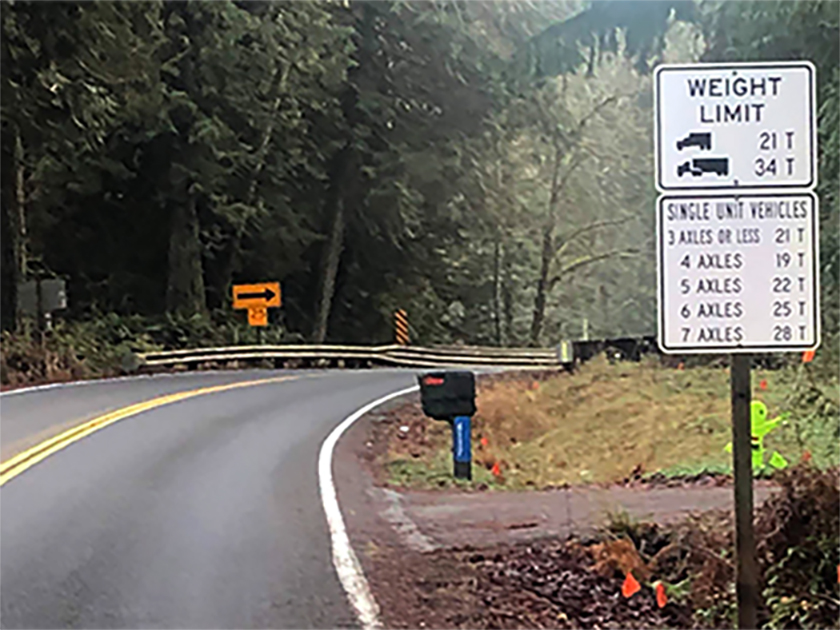Bridge load limits and permits in unincorporated King County

Example of a load limit sign in unincorporated King County: Ames Lake Trestle Bridge No. 1320A.
Overlegal truck permit process for crossing King County-owned bridges
List of restricted bridges and posted load limits/vertical clearances (573KB)
Who needs a King County Overlegal Permit?
King County encourages you to check that your truck loads and configurations are within the legal load or posted load limits and have similar axle spacings. King County will pursue liability for any bridge damage caused by overlegal trucks without permits, and/or noncompliance with the conditions of the permit.
Trucks that require permits include:
- Trucks which exceed legal load limits, as administered by WSDOT. (See WSDOT Vehicles Size and Weight information.
- Trucks that exceed the posted load limits or have different axle spacing configurations than the posted load limit signs.
A separate analysis for axle loads and configurations that are different from the previously rated standard trucks must be performed before a permit can be issued. Once performed, that analysis can be used for future permit requests, providing that the bridge conditions are unchanged.
It should be noted that King County overlegal permits apply only to King County-owned bridges, and separate permits should be obtained for bridges owned or maintained by the state or individual cities as necessary.
Overlegal Permit application information
Information you need to apply for a King County overlegal truck permit:
- Planned route, naming each King County road to be used
- Truck length, height, width, and total weight
- Axle spacings, axle loadings, and number of wheels
- Brief description of the load being carried
- The date(s) and number of trips planned
- Copy of Washington State permit (if applicable)
- License number of power unit
Overlegal Permit application process
- Once you have determined all of the applicable information from the above list, please complete and sign the Application Form and the Equipment weight and axle spacing report (see "Application Forms" below) and email them to King County Road Services at permits.roads@kingcounty.gov. If you have other questions, please contact Road Services at permits.roads@kingcounty.gov or 206-477-6531.
- Road Services staff will file your application, assign an application number, and forward all the information to the bridge engineer for review.
- For trucks that have been rated before, a permit can typically be issued within one working day, provided that the condition of the bridge has not changed. King County suggests that you allow a minimum of one day for permits on previously rated trucks, since the assigned staff has multiple functions and may not be immediately available.
- For trucks that have not been rated before, please allow a minimum of three working days for the engineer to perform a bridge analysis and evaluation to determine if a permit can be issued for your truck.
- The reviewed application and permit are returned to Road Services, where they will be emailed to you. A flow chart describing the overlegal load permit process can be viewed for your reference.
Pre-approval process
Trucks that will routinely carry overlegal loads on a specific route(s) of bridge crossings may be eligible for pre-approval and be given longer duration permits for those loads and routes. King County encourages the use of this timesaving service for all frequent haulers of overlegal loads. The application process is the same as listed above.
Application forms
Instructions: Open, print, fill in the form and email it to the address on the top of the form.
- Application For Overlegal Load Permit To Cross King County-Owned Bridges (187KB)
- Equipment Weight And Axle Spacing Report (579KB)
- Flow Chart: King County Overlegal Load Truck Permit Process (9KB)
Purpose
The primary purpose behind the rating and permit process is to protect the public’s safety and preserve their investment, while also serving their need for special transportation. Excessive frequencies of overloads on bridges will induce long-term damage to the bridge structure, reducing the bridge's useful life and increasing the chance of catastrophic failure.
King County bridges
King County owns and maintains 185 bridges in the unincorporated county area. All bridges in King County have been analyzed for load capacity using standard AASHTO truck loadings. Currently, there are 10 county bridges that cannot meet the load criteria established by AASHTO, and therefore require load restrictions. These bridges were designed and built to carry smaller loads, or they have deteriorated over time from frequent high loads and harsh weather conditions.
The county maintains a database of bridge load ratings based on standard AASHTO truck configurations for each bridge. These standard AASHTO trucks are shown at the top of the King County Restricted Bridges list. The capacity of each bridge to carry overlegal loads varies according to the individual bridge and the truck configuration (axle spacing and axle loads.) County engineers inspect the condition of these bridges on a two-year cycle, with some bridges getting more frequent inspection. The engineer may revise the existing posting or initiate new load restrictions on the bridges that are found to have deficiencies that reduce their capacity.
Background
The catastrophic failure of Ohio's Silver Bridge in December 1967 during a pre-holiday rush hour sparked a national program aimed at monitoring the safety of the country's bridges. By 1971, the National Bridge Inspection Standards (NBIS) was issued by the Federal Highway Administration (FHWA.) The NBIS established a national policy for uniform inspection procedures and schedules.
A 1988 amendment to the NBIS required that all bridges be rated for load capacity and that bridges that do not meet the standard criteria be posted with their restricted load amounts. Load ratings are determined based on the as-built structural elements and the results of field condition inspection, and are performed according to standard practices developed by the American Association of State Highway Transportation Officials (AASHTO.)

 Translate
Translate